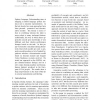Free Online Productivity Tools
i2Speak
i2Symbol
i2OCR
iTex2Img
iWeb2Print
iWeb2Shot
i2Type
iPdf2Split
iPdf2Merge
i2Bopomofo
i2Arabic
i2Style
i2Image
i2PDF
iLatex2Rtf
Sci2ools
EACL
2009
ACL Anthology
2009
ACL Anthology
Re-Ranking Models for Spoken Language Understanding
Spoken Language Understanding aims at mapping a natural language spoken sentence into a semantic representation. In the last decade two main approaches have been pursued: generative and discriminative models. The former is more robust to overfitting whereas the latter is more robust to many irrelevant features. Additionally, the way in which these approaches encode prior knowledge is very different and their relative performance changes based on the task. In this paper we describe a machine learning framework where both models are used: a generative model produces a list of ranked hypotheses whereas a discriminative model based on structure kernels and Support Vector Machines, re-ranks such list. We tested our approach on the MEDIA corpus (human-machine dialogs) and on a new corpus (human-machine and humanhuman dialogs) produced in the European LUNA project. The results show a large improvement on the state-of-the-art in concept segmentation and labeling.
Discriminative Models | EACL 2009 | Human-machine Dialogs | Language Spoken Sentence | Natural Language Processing |
| Added | 24 Nov 2009 |
| Updated | 24 Nov 2009 |
| Type | Conference |
| Year | 2009 |
| Where | EACL |
| Authors | Marco Dinarelli, Alessandro Moschitti, Giuseppe Riccardi |
Comments (0)

